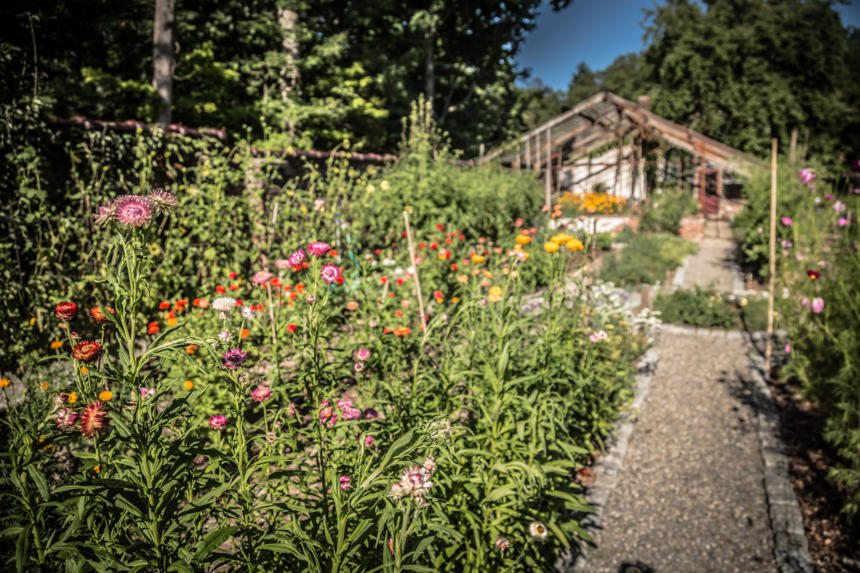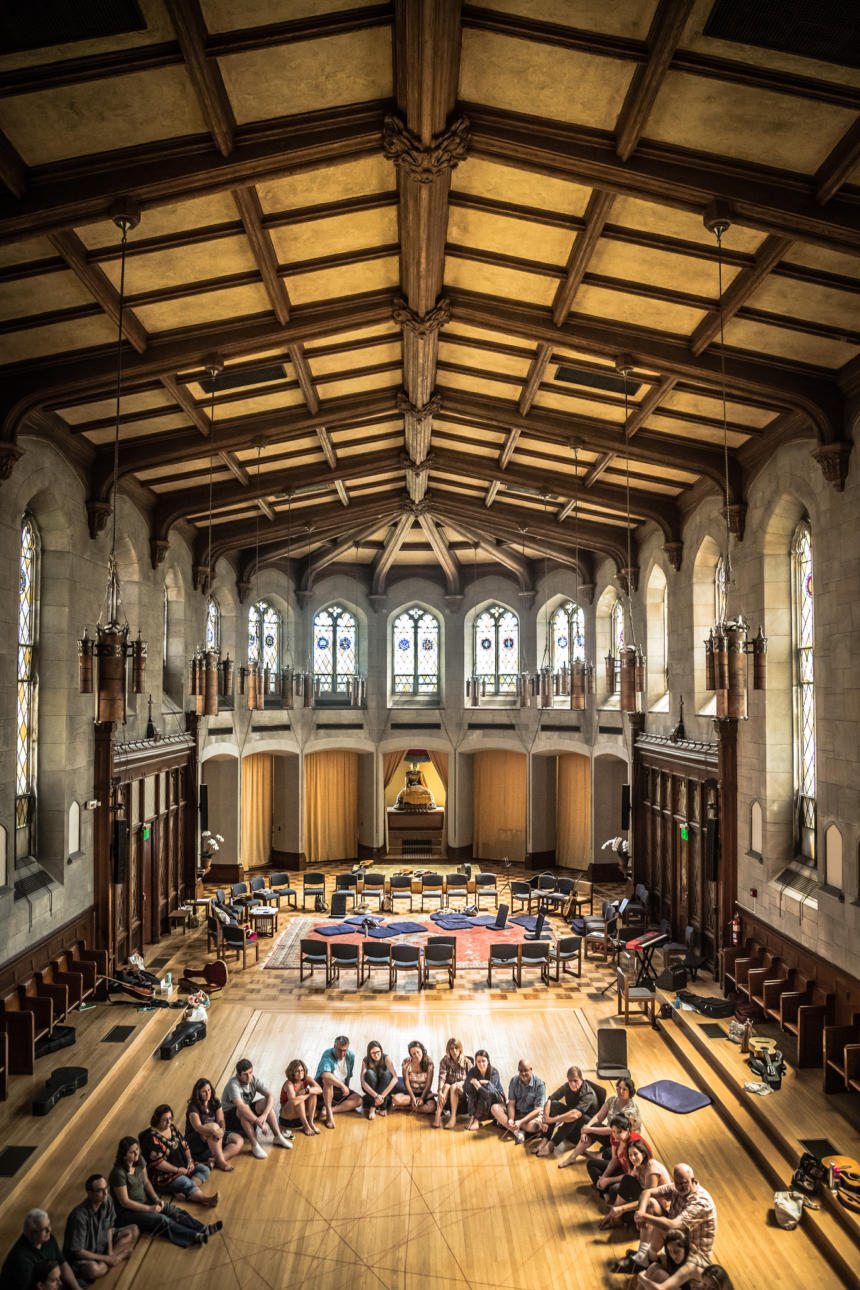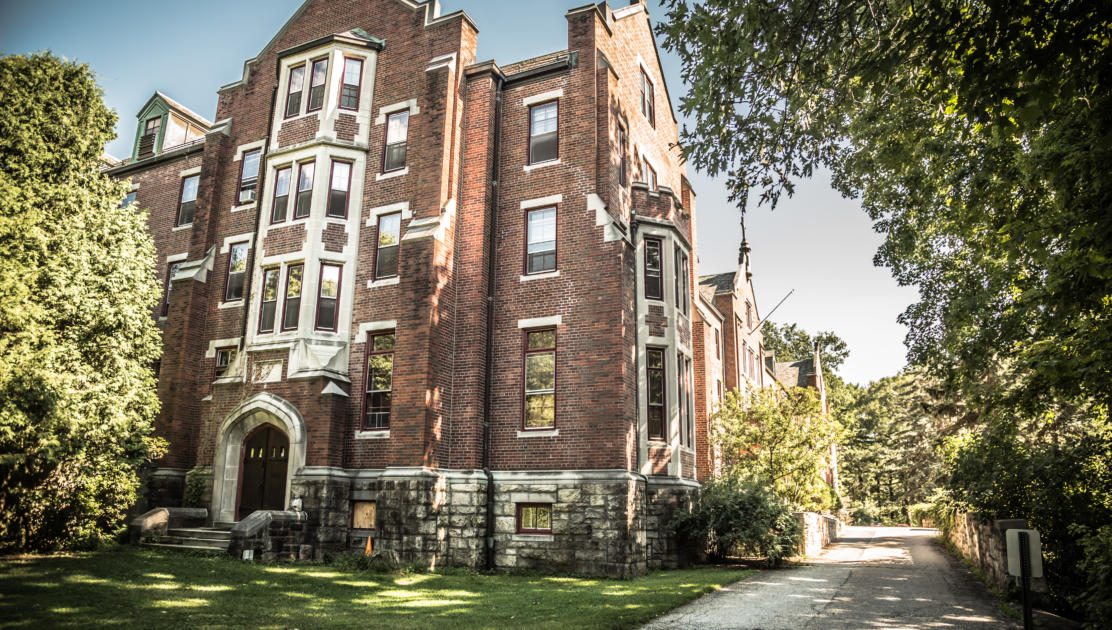Our Commitment to Sustainability
By Garrison InstituteAt the Garrison Institute, we believe our current ecological crisis is also a spiritual crisis—one that asks us to both deepen our emotional, intuitive, and embodied ways of relating to the earth and to expand our collective sense of perspective, meaning, and solidarity around the global crisis. However, in addition to our efforts to encourage a societal shift around profound ecological issues, we also get in the weeds, as it were, with our efforts to understand, measure, and minimize the environmental impact of our operations at the Institute.
Although our building was not originally designed for energy efficiency, the Garrison Institute inherited an ethos of simplicity and stewardship from the monks who lived on the premises when it was a Capuchin monastery. That sensibility combined with one of the Garrison Institute founders Jonathan Rose’s experience as a developer of affordable, environmentally responsible communities led to an initial renovation of the building that was simple but efficient. First, because 15% of heat loss in buildings occurs through the floors, they restored the old floors. Then they re-painted the building’s interior with low-VOC paints, which are more cost-effective and less harmful to human and environmental health. They completely remade the bathrooms, using low flow fixtures, and installed more energy efficient lights throughout the building—at that time, compact fluorescents. They rolled up their sleeves, caulking around the old window frames and insulating exposed pipes. Then they replaced the old boilers with new efficient ones.
“We tried to apply the Institute’s mission to the design of the building,” Rose says. “Energy and resource conservation flowed from the monastic facility’s natural simplicity.”
When the Garrison Institute first opened its doors, all of the furnishings were made from sustainably harvested woods in the Hudson Valley. Many of the pieces were made by Amish farmers. At that time, they started the ongoing work of restoring the gardens by planting a vegetable and herb garden for the Institute’s kitchen.

In the years that followed, more ambitious efforts were made to lower the environmental impact of the Institute’s operations. The onsite sewer system was rebuilt according to the current environmental standards. A new geothermal system was installed, providing cooling and heating for the Meditation Hall, Chapel, and Auditorium.
A lot of energy waste in old buildings is the result of how challenging it can be to manage the heating systems. In recent years, the Institute’s maintenance team has worked to perfect the balancing act of letting the building go cold when it’s not occupied, while giving rooms enough time to warm up before guests arrive. Right now, that process involves a human being going into each individual room and preparing the temperature. Eventually, the goal is to find and implement a smart thermostat system that would be able to control individual rooms in the building by remote control.
A recent triumph for our sustainability efforts occurred when we transitioned from a very old style of a water-cooled refrigeration system to an air-cooled system. We were previously using 7,000 gallons of potable drinking water a day to cool our kitchen’s refrigerators and walk-in cooler. In addition to the water saved in this process, this made a huge impact on our electrical consumption because the system used hydroelectric energy to pump water up from our 600-foot-deep wells to the top of our 90-foot water tower and back down into the building.
 In the most critical areas, we have replaced all of the compact fluorescent lightbulbs that were used during the initial renovations with the more efficient LED light bulbs. Changing light bulbs in our Meditation Hall is a bigger challenge than you might expect—there isn’t a ladder made that is tall enough to reach the upper bulbs in our vaulted ceilings! We had to bring in a man-lift for that purpose. As a result of these efforts, from the beginning of December 2015 to the end of January 2017, we used one-third fewer kilowatt hours of electricity compared to the same months the previous year. Transitioning all of the guest bedrooms and hallway lights to LED bulbs remains an ongoing project.
In the most critical areas, we have replaced all of the compact fluorescent lightbulbs that were used during the initial renovations with the more efficient LED light bulbs. Changing light bulbs in our Meditation Hall is a bigger challenge than you might expect—there isn’t a ladder made that is tall enough to reach the upper bulbs in our vaulted ceilings! We had to bring in a man-lift for that purpose. As a result of these efforts, from the beginning of December 2015 to the end of January 2017, we used one-third fewer kilowatt hours of electricity compared to the same months the previous year. Transitioning all of the guest bedrooms and hallway lights to LED bulbs remains an ongoing project.
We’ve also recently implemented a single-stream recycling system, which is helping us reduce our overall waste.
With these projects and others—such as continuing to seal doors, upgrading the storm windows, and making the guest room thermostats more user-friendly—the Institute’s sustainability efforts really come down to making many, small incremental changes over time. These changes come in the form of upgrading our technology, making use of best practices, and, perhaps most importantly, making a collective effort to improve our individual behaviors.
Below is an overview of the current state of our ongoing work.
Energy Efficiency
- We have a geothermal system for our Meditation Hall and Auditorium that uses ground water for cooling and heating.
- We use compact fluorescent lightbulbs in at least 75% of fixtures facility-wide.
- We have installed motion sensor lighting controls in low traffic areas, and we turn off hall lights at night.
- We use EnergyStar rated appliances.
- We insulate water heaters, storage tanks, and hot water pipes.
- We have upgraded our windows for better energy efficiency.
- We clean light fixtures and diffusers regularly for optimal light output.
- We use natural ventilation instead of mechanical air conditioning in the majority of the facility.
- We have installed ceiling fans in large spaces to efficiently improve air flow.
- We have programmable thermostats set at energy efficient settings in both hot and cold weather.
- As we are very close to the Metro-North Hudson Line’s Garrison train station, we operate a shuttle van to the station and we encourage our visitors to travel to us by train.
Water Efficiency
- We operate our own water treatment and sewage system using wells on our property and employing organic filtering and treatment processes.
- We use our own reusable five gallon water bottles and our own water rather than offering commercial bottled water to guests.
- We have replaced all pre-1992 toilets with low water use models.
Sustainable Food
- Our kitchen prepares nourishing, delicious food that is mostly vegetarian. We have long-standing relationships with local farmers and food makers in the Hudson Valley that we proudly support. During the growing season much of the produce we serve is local and grown organically. Throughout the year these growers provide us with local eggs, dairy, grains, vegetables from the root cellars, honey, maple syrup, and more. When we serve meat, we buy from Hudson Valley or regional farms where the animals are raised in a humane manner and without the use of hormones and antibiotics. We buy fish according to Seafood Watch recommendations.
- We have a small kitchen garden, which supplies some of our herbs and vegetables. We also have a cutting garden to provide some of our flowers.
- We purchase organic, shade grown coffee.
Eco-Conscious Purchasing
- In addition to food, we purchase the majority of our supplies of all kinds from local and ecologically aware sources, including office supplies, cleaning supplies and equipment and food.
- All of our paper towels and toilet paper are at least 30% post-consumer recycled content.
- We purchase all our supplies in bulk to reduce shipping mileage.
- We use bamboo grown on the premises for fences.
Eliminating Toxic Chemicals and Pollution
- We purchase biodegradable cleaning products for daily use.
- We use low volatile organic compound (VOC) paint products purchased from a local supplier.
- We supply organic, fragrance-free personal care products for guests.
- We use rechargeable batteries rather than disposable alkaline.
- We do not use chemical pesticides in our gardens. We pick weeds by hand rather than use herbicides (retreat guests sometimes help as part of their work practice).
Solid Waste Management
- We recycle all paper and cardboard products, cans, glass, and plastic.
- We recycle food scraps for use as animal feed.
- We do not use any non-recyclable plastic food containers.
- We re-use packaging material (bubble wrap, “peanuts”, cardboard, etc).
- We re-use clean trash can liners.
- We rely on online communications as much as possible to reduce paper use.
- Our copiers print front and back to save paper.
- We update our mailing list regularly to avoid sending to wrong or duplicate addresses.

It is all good. The best personally is shuttle from train to your institute.Although from time to time, I still like to drive ,up north to recharge energy.
Wish your good works continue. Thx